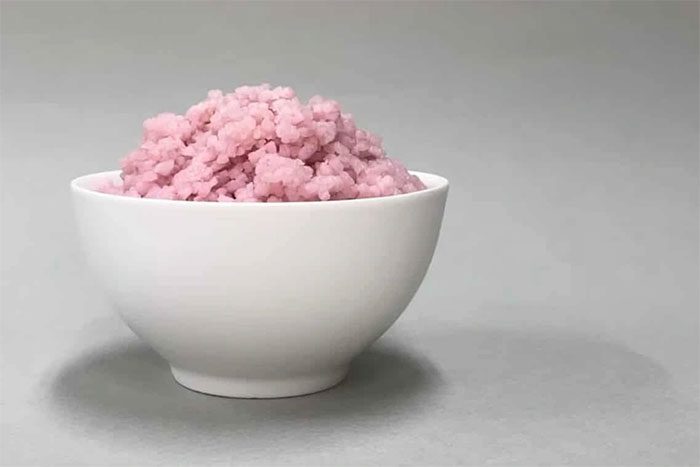South Korean researchers have created beef rice for the first time by culturing stem cells from adipose and skeletal muscle in rice grains.
This new food is more nutritious than regular rice and has a lower risk of allergies compared to other synthetic meats.

Beef hybrid rice is pink, nutrient-rich, and environmentally friendly. (Photo: Yonsei University).
Importantly, it can serve as an affordable protein alternative with lower carbon emissions than beef.
The current climate crisis demands that countries transform their food production systems.
Food production—ranging from farming to animal husbandry to consumption—is one of the largest sources of carbon emissions globally.
Beef, in particular, has been highlighted for its heavy environmental impact, emitting nearly 50 kg of CO2 per 100 grams of protein.
Environmental pressures on the food production sector are increasing as the global population grows. This may lead to a global food crisis without sustainable agricultural systems.
Many alternative protein sources are being researched for this purpose, such as proteins from insects, algae, and lab-grown meat.
However, the proposed solutions so far still have numerous limitations regarding reproducibility, flavor, nutritional value, cost competitiveness, and reduced environmental impact.
Hybrid foods, which include both plant and animal components, show great potential for sustainable, healthy, and affordable diets.
In this context, researchers from Yonsei University in South Korea have developed beef hybrid rice that encompasses all these benefits.
Researcher Sohyeon Park from Yonsei University stated: “Imagine that we could get all the essential nutrients from beef hybrid rice. Rice already has a high nutrient content, but adding cells from livestock could enhance these nutritional values.”
Reducing allergy risk, improving flavor, and lowering carbon emissions
In complex organisms, the biological environment supports cell growth to form three-dimensional tissues and organs.

Beef hybrid rice created from beef muscle and stem cells. (Photo: Yonsei University).
To cultivate meat, Yonsei researchers simulated this environment using rice. The rice grain, with its porous structure, serves as a medium for the growth of cow cells.
On the other hand, rice contains essential nutrients such as carbohydrates, lipids, and plant proteins, as well as minerals like phosphorus, calcium, and magnesium.
It also contains functional nutrients, such as glutelin and folic acid, which play essential roles in the metabolic activities of skeletal muscle cells.
In the cell culture environment, rice grains act as a nutrient substrate that promotes cell proliferation.
Additionally, rice has a lower allergy rate. This is crucial for cultivating artificial meat, which can also be derived from soybeans or other seeds. However, these are common allergens.
Furthermore, artificial meat is only compatible with a limited number of cell types, forcing scientists to use many additives to flavor the product.
The South Korean researchers utilized both skeletal muscle and adipose cells to best replicate the flavor, texture, and nutritional value of natural meat.
To achieve this, they coated the rice grains with a layer of fish gelatin—a healthy and edible ingredient—allowing the cells to adhere better to the rice grains. Enzymes were also added to stimulate cell proliferation.
Then, adipose stem cells and cow muscle cells were introduced into the rice and cultured for 9 to 11 days.
“I didn’t expect the cells to grow so well in the rice,” said Sohyeon Park, the lead author of the study.
According to the research team, the final product meets all food safety and nutritional standards.
To describe the characteristics of the beef rice, scientists steamed and analyzed its nutritional value, aroma, and texture.
The results showed that it contains 8% more protein and 7% more fat than regular rice.
In terms of texture, the rice is pink, firmer, and crunchier after cooking. The higher muscle cell content gives it a delicate aroma of cooked beef and almonds, while the lipids lend the rice the scent of butter and coconut oil.
Moreover, producing this beef hybrid rice emits less than 6.27 kg of CO2 per 100 grams, nearly equivalent to the carbon emissions of chicken meat.
If marketed, it would be priced at about $2.23 per kg, compared to $14.88 per kg for beef.
However, before this product can be commercialized, the research team plans to investigate better development conditions to enhance the nutritional value of the product.
“This research shows that we have a lot of potential to produce grain-derived hybrid foods. One day, this could be used as food aid during famines, rations for the military, or even space food,” concluded Sohyeon Park.


















































